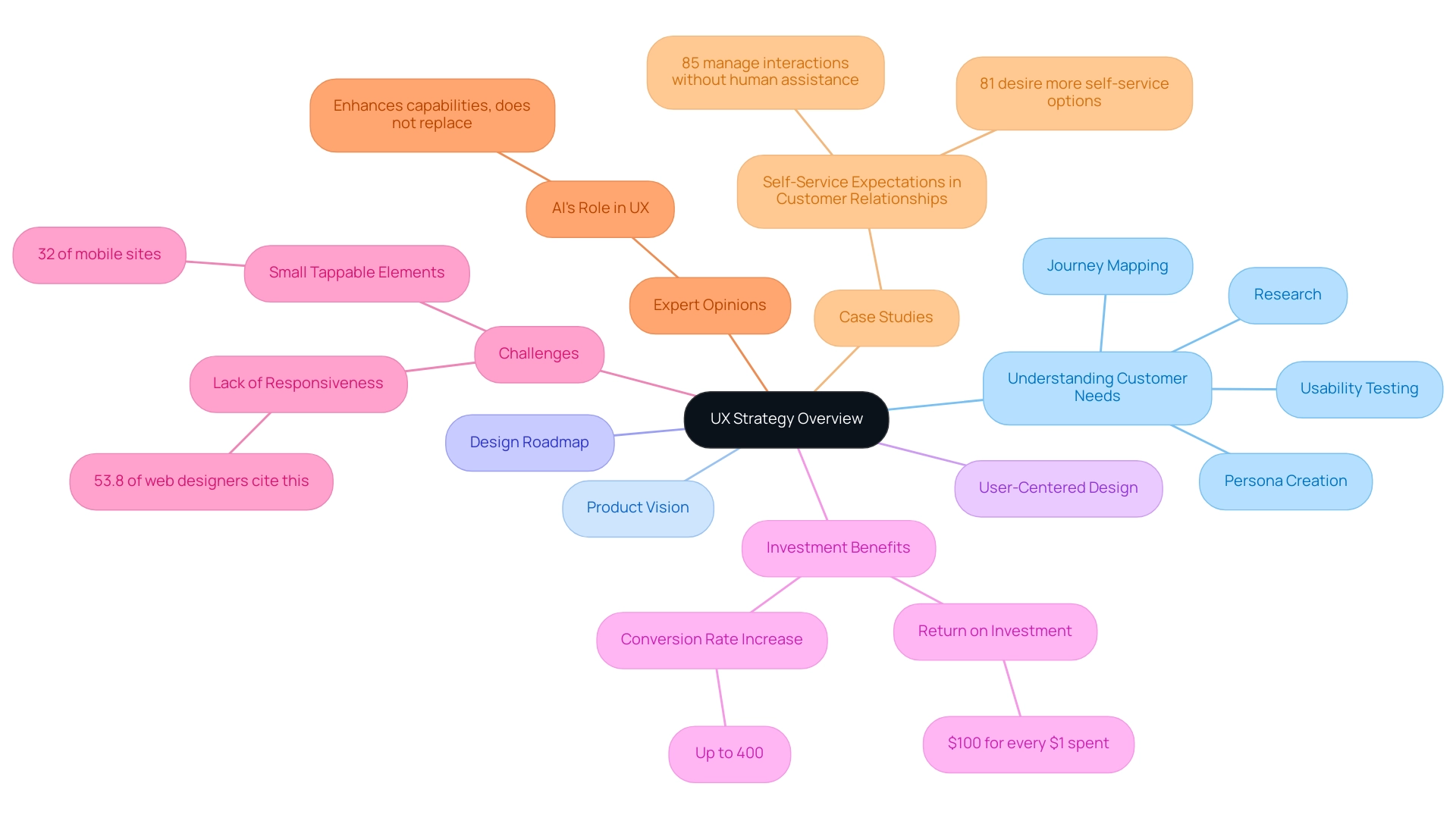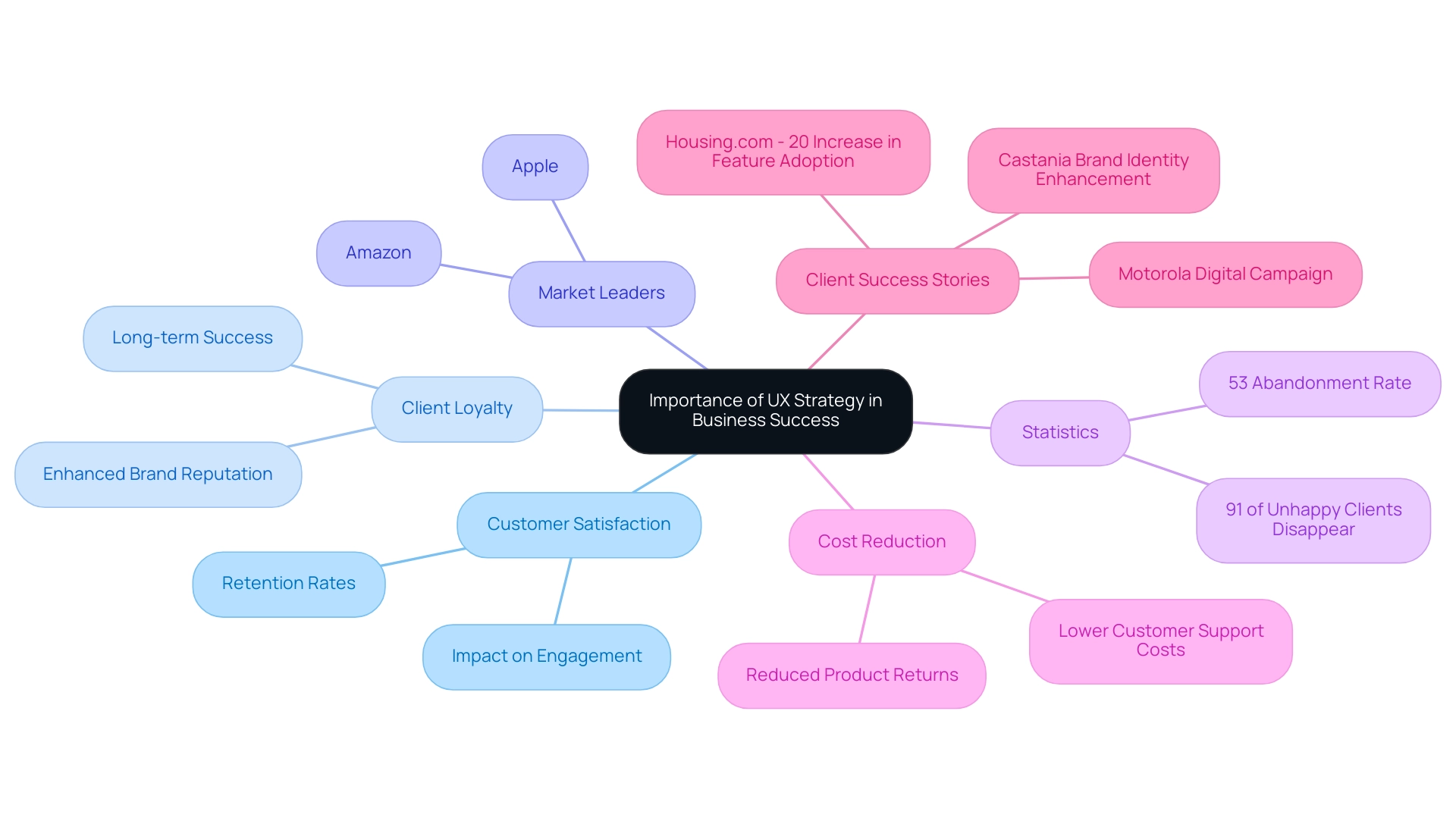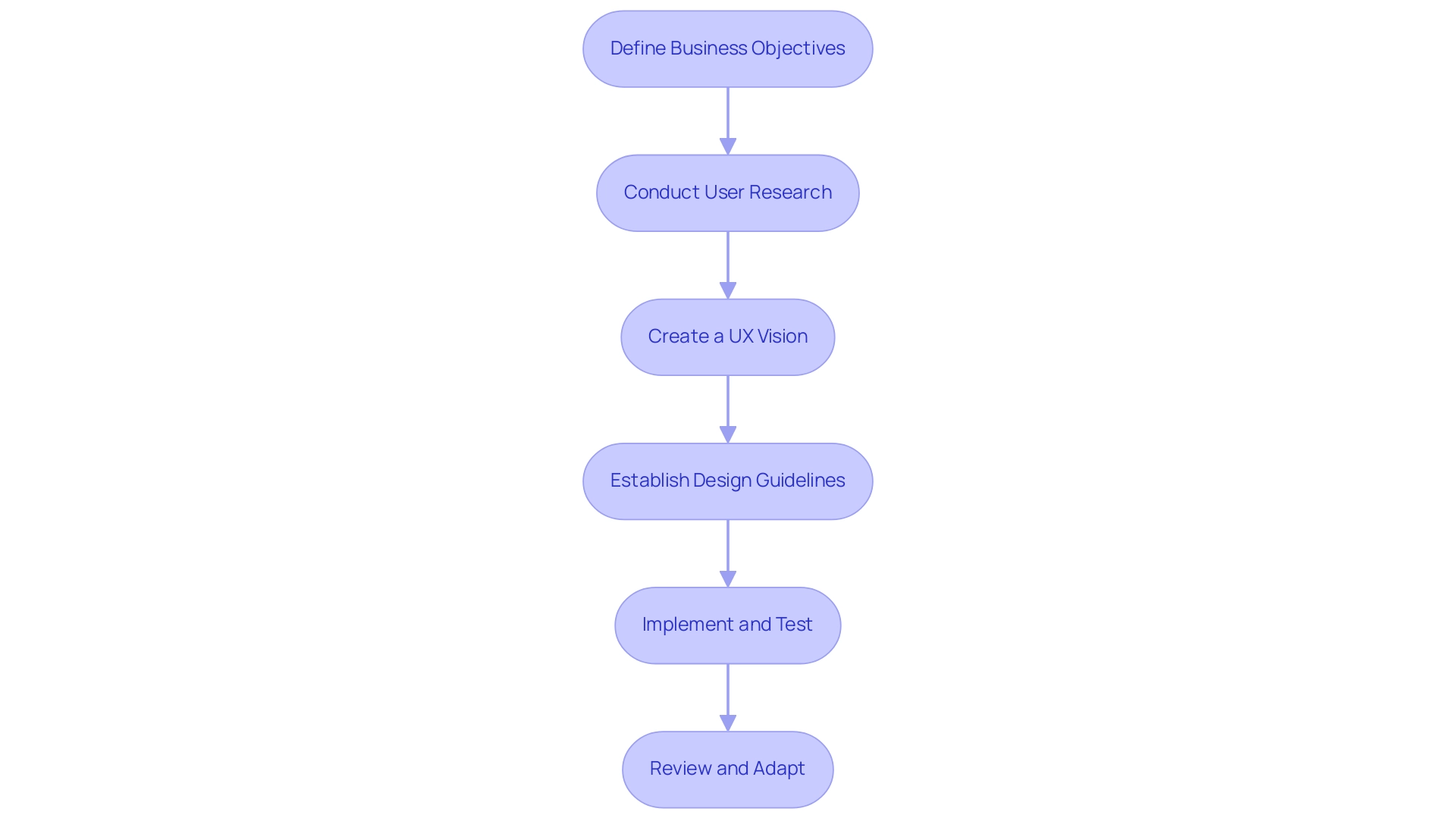Digital Branding Strategies
What Is UX Strategy? Understanding Its Importance and Components
Overview
UX strategy serves as a comprehensive framework designed to enhance user experiences in alignment with overarching business objectives. This approach underscores the critical importance of understanding customer needs while establishing a structured design roadmap. Key components of this strategy include:
- User research
- Design principles
- Performance metrics
The profound impact of a robust UX strategy on customer satisfaction, engagement, and, ultimately, business success cannot be overstated. By implementing these elements, organizations can significantly elevate their user experience, driving both engagement and loyalty.
Introduction
In a digital landscape where user expectations evolve at an unprecedented pace, the importance of a well-defined UX strategy is paramount. This comprehensive framework not only enhances user satisfaction but also aligns seamlessly with overarching business goals, driving growth and fostering customer loyalty.
By delving into the core components of effective UX strategies—such as user research, design principles, and performance metrics—businesses can create intuitive experiences that resonate with their audience.
Through insightful case studies and expert perspectives, this article explores the transformative power of prioritizing user experience, offering practical steps to avoid common pitfalls in strategy development.
As organizations strive to remain competitive, understanding and implementing a robust UX strategy becomes essential for success in today’s market.
Defining UX Strategy: An Overview
The UX approach is a comprehensive framework that delineates how a business aims to enhance individual experiences in alignment with its broader business objectives. This approach necessitates a profound understanding of customer needs, a clear articulation of the product vision, and the establishment of a structured roadmap for design and development. By prioritizing a user-focused design, a meticulously crafted UX strategy ensures that every design decision is made with the end user in mind, culminating in a more effective and satisfying experience.
In today’s competitive landscape, where individual expectations are rapidly evolving, the importance of a robust UX strategy cannot be overstated. Studies indicate that a well-structured interaction can boost conversion rates by as much as 400%. Moreover, companies investing in UX can anticipate an impressive return of $100 for every dollar spent, underscoring the financial advantages of prioritizing client experience.
It is crucial to highlight that 32% of mobile sites feature tappable elements that are excessively small, emphasizing a significant challenge that UX strategies must address.
The components of an effective UX approach encompass research, persona creation, journey mapping, and usability testing. These elements synergistically contribute to a comprehensive understanding of the target audience and their interactions with the product. Notably, 53.8% of web designers identify a lack of responsiveness across devices as a primary reason for website redesigns, according to GoodFirms, which underscores the necessity of a responsive UX approach.
Case studies illustrate the practical application of UX methodologies in businesses. For instance, the shift toward self-service options in customer relationships has become paramount, with 85% of customers managing their interactions without human assistance. This trend underscores the imperative for brands to adapt by prioritizing intuitive digital interactions that align with consumer preferences.
To retain customer loyalty, brands must ensure that their digital experiences are seamless and effective, particularly in light of the pandemic’s impact on customer expectations.
Expert opinions further accentuate the significance of UX planning. While AI is poised to augment the capabilities of UX designers, it cannot replicate the essential human empathy and creativity that underpin effective design. Therefore, a clearly articulated UX strategy not only enhances customer satisfaction but also aligns closely with organizational objectives, ultimately fostering client loyalty and promoting growth.

The Importance of UX Strategy in Business Success
A robust UX strategy is essential for achieving business success, as it significantly impacts customer satisfaction and engagement. Businesses that prioritize customer satisfaction are more likely to experience enhanced client loyalty, increased conversion rates, and a fortified brand reputation. Industry leaders such as Apple and Amazon exemplify this, having thrived through the implementation of user-centric design principles, which have resulted in a loyal customer base and substantial market share.
Statistics indicate that 53% of mobile site visitors abandon a webpage if it takes longer than three seconds to load, highlighting the critical role of efficient UX design in retaining potential customers.
Furthermore, a well-executed UX strategy can lead to decreased costs associated with customer support and product returns, as consumers are more likely to appreciate products that effectively cater to their needs.
Client success stories further underscore the financial advantages of prioritizing UX. For instance, Housing.com enhanced its search capabilities to boost customer satisfaction, resulting in a remarkable 20% increase in feature adoption. Similarly, the brand identity enhancement for Castania and the digital campaign for Motorola illustrate how strategic UX improvements can directly influence customer behavior and drive organizational outcomes.
It’s crucial to recognize the stakes involved; 91% of dissatisfied clients who do not voice their concerns simply disappear without providing feedback, underscoring the consequences of neglecting user interaction. Additionally, the customer journey encapsulates the entire experience with a product, where the UX strategy ensures intuitive and seamless interactions at every stage, fostering engagement and loyalty. In conclusion, the significance of a user-centric design approach cannot be overstated. It not only encourages engagement and loyalty but also equips organizations for long-term success in a competitive marketplace.

Core Components of an Effective UX Strategy
An effective UX approach is constructed from several crucial elements that collaborate to improve satisfaction and promote business success. These components include:
-
Participant Research: This foundational element involves a deep understanding of needs, behaviors, and pain points. Employing both qualitative and quantitative research methods allows organizations to gather insights that inform design decisions.
Significantly, organizations with advanced research practices are 1.9 times more likely to report enhanced customer satisfaction, emphasizing the essential role of consumer research in UX planning. As Ella Webber states, “Organizations with mature research practices are 1.9x more likely to report improved customer satisfaction.”
-
Vision and Goals: Establishing a clear vision for the experience is vital. This vision should align with measurable goals that reflect broader business objectives, ensuring that it supports the overall success of the UX strategy.
-
Design Principles: Establishing a set of design guidelines is essential for maintaining consistency across all interaction touchpoints. These principles assist in guiding design choices and guarantee that the experience remains cohesive and intuitive.
-
Performance Metrics: Identifying key performance indicators (KPIs) is essential for measuring the success of the UX approach. By monitoring these metrics, companies can make data-informed modifications to improve engagement and retention.
Incorporating these elements enables companies to create a comprehensive UX strategy that not only fulfills expectations but also promotes measurable results. For example, the impact of customer research techniques is highlighted by the statistic that 76% of participants will switch to a rival after just one unfavorable encounter with a brand they usually prefer. This underscores the necessity of prioritizing user experience in today’s competitive landscape. Moreover, platforms such as WordPress, which supports 39.5% of all websites, illustrate the significance of effective UX approaches in reaching a wide audience.
By concentrating on these essential elements, organizations can establish a user-centric approach that encourages loyalty and satisfaction, ultimately resulting in sustained growth. WonderEight distinguishes itself by merging creativity with technology, as illustrated in their successful projects such as the brand identity enhancement for Castania and the digital campaign for Motorola, highlighting real-world applications of effective UX methods.
Steps to Develop a Comprehensive UX Strategy
Developing a comprehensive UX strategy is a vital endeavor that encompasses several critical steps, ensuring alignment with both business goals and user needs:
-
Define Business Objectives: Start by pinpointing the overarching business goals that the UX plan must support. This foundational step guarantees that the experience is not solely centered around individuals but also strategically aligned with the company’s UX strategy.
-
Conduct User Research: Gather insights about your target audience through various methods such as surveys, interviews, and usability testing. Understanding client needs and preferences is crucial; effective research has been shown to significantly enhance the development of UX strategy, resulting in improved engagement and satisfaction. For example, personalizing push notifications can boost reaction rates by up to 400%, underscoring the importance of engagement strategies in the UX process.
-
Create a UX Vision: Formulate a clear vision statement that encapsulates the desired experience. This vision should align with the defined business objectives and act as a guiding light throughout the UX strategy design process, ensuring consistency and focus.
-
Establish Design Guidelines: Develop design principles that will steer the creation of interfaces and interactions. These guidelines should reflect the UX strategy and facilitate a cohesive interaction across all touchpoints.
-
Implement and Test: Launch the product or service while continuously testing and iterating based on audience feedback and performance metrics. This iterative process is essential for refining the interaction as part of the UX strategy and addressing any issues that may arise post-launch. As noted by David Fischer, director of Greenventory, “The experience of individuals was significantly improved, resulting in higher satisfaction and engagement metrics.” Individuals reported a smoother and more intuitive interface, leading to increased task completion rates and fewer mistakes.
-
Review and Adapt: Regularly assess the effectiveness of the UX strategy. This entails examining client feedback and performance data to make necessary adjustments, ensuring that the approach remains aligned with evolving consumer needs and business objectives. The pandemic has shifted customer expectations, with 81% of consumers now desiring more self-service options. Brands must adapt to these expectations by offering seamless self-service experiences, or risk losing customers to competitors who do.
Incorporating these steps into your UX strategy not only enhances user satisfaction but can also lead to significant cost savings over time by minimizing the need for costly redesigns and updates. Furthermore, leveraging AI-enabled practitioners can assist in developing and implementing these methods, aligning with the innovative approach of WonderEight. As companies adapt to shifting consumer expectations, particularly the growing demand for self-service options, a clearly defined UX strategy becomes essential for sustaining competitive advantage.

Common Mistakes to Avoid in UX Strategy Development
In the development of a successful UX strategy, businesses must be vigilant about several common pitfalls that can significantly impede progress:
- Neglecting Research: Failing to conduct comprehensive research on users is a frequent misstep. This oversight can lead to a fundamental misunderstanding of client needs and preferences, ultimately resulting in products that do not resonate with the target audience.
- Overlooking Business Goals: A UX strategy that does not align with overarching business objectives can squander resources and miss valuable opportunities. It is crucial for UX initiatives to support and enhance the company’s strategic vision.
- Ignoring Feedback: The absence of feedback from individuals during the design and testing phases can create a disconnect between the product and its audience. Incorporating feedback is essential; 74% of individuals are more likely to return to a mobile-friendly site, underscoring the importance of client-centric design.
- Lack of Iteration: A fixed UX approach that fails to adjust to changing consumer needs and market trends risks becoming outdated. Ongoing iteration driven by insights guarantees that the UX remains pertinent and efficient.
- Poor Communication: Ineffective communication of the UX strategy among teams can lead to inconsistencies and misalignment in design efforts. Clear communication fosters collaboration and ensures that all stakeholders are on the same page.
Statistics reveal that 96% of individuals have encountered websites lacking mobile optimization, and 53% abandon a mobile site if it takes longer than three seconds to load. This highlights the importance of prioritizing experience in digital environments. Furthermore, personalizing push notifications can increase reaction rates by up to 400%, demonstrating the power of customized engagement.
As Annemarie Bufe, Content Manager, asserts, “Investing in UX design is essential for companies because it can have a significant impact on the success of their products.” This emphasizes the critical nature of addressing these common pitfalls.
Case studies illustrate the consequences of neglecting user research. For instance, companies that fail to incorporate video content—53 times more likely to achieve high visibility on Google—miss out on significant engagement opportunities. Indeed, 73% of consumers are influenced to buy through video content, highlighting the necessity for companies to incorporate effective multimedia approaches into their UX design.
By identifying and tackling these frequent errors, companies can foster a more efficient and customer-focused UX approach, ultimately resulting in greater satisfaction and enhanced organizational results.
Case Studies: Successful UX Strategies in Action
Numerous companies have adeptly harnessed their UX strategy to significantly enhance user experience and drive positive business outcomes. For instance, Airbnb undertook a comprehensive overhaul of its platform, grounded in extensive consumer research. This initiative led to a more intuitive interface, which not only enhanced engagement but also resulted in a notable increase in bookings.
Similarly, Spotify utilized feedback from listeners to enhance its music recommendation algorithms, achieving greater satisfaction and retention rates as a result.
In recent developments, PrimePro created an easy-to-understand interface by investing time in understanding their audience’s needs, while Stradigi redesigned their low-code AI platform to serve organizational clients. These examples underscore the transformative impact of a well-executed UX strategy, demonstrating how it can propel business success and cultivate customer loyalty.
Dropbox serves as another compelling example; the company concentrated on streamlining its onboarding process, thereby simplifying the introduction of new individuals to the platform’s features and benefits. The influence of effective UX strategies is further illustrated by the fact that over 37,000 teams across more than 80 countries depend on tools like UXCam to improve their experience. This data reflects a growing recognition of the importance of user-centered design in today’s competitive landscape.
As Ella Webber aptly states, “AI can’t replicate human empathy and creativity—crucial for understanding needs and making intuitive design judgments.” This highlights the critical role that thoughtful design plays in achieving measurable business outcomes. As companies continue to prioritize their UX strategy, the results speak for themselves, demonstrating the effectiveness of integrating human-centered approaches in design.
At WonderEight, we focus on developing a thorough UX strategy that not only improves engagement but also generates measurable outcomes. Our campaigns for brands such as Miranda and Quaker Oats illustrate our dedication to providing engaging content and meaningful brand interactions. By utilizing creative approaches and instruments customized to our clients’ distinct requirements, we guarantee that our UX strategy stands out in the competitive environment, ultimately promoting customer loyalty and business success.
The Evolving Nature of UX Strategy: Iteration and Adaptation
The landscape of experience (UX) is in a state of constant evolution, propelled by rapid technological advancements and shifting expectations. Consequently, an effective UX strategy must be both adaptable and iterative. Ongoing testing and feedback loops are essential for refining designs to align with the ever-changing needs of clients.
For instance, companies like Netflix exemplify this iterative approach, consistently updating their interface based on viewer preferences and engagement metrics. This commitment to adaptation not only enhances satisfaction but also drives engagement.
Statistics reveal that 32% of websites feature tappable elements that are too small, complicating navigation and detracting from the user experience. Such insights underscore the necessity for organizations to deepen their understanding of the importance of UX strategy and to cultivate environments where design is recognized as a vital driver of success. As one expert noted, “To tackle these challenges, organizations must enhance their understanding of the strategic significance of UX strategy and create environments where design is regarded as a critical driver of success.”
Moreover, the evolving nature of UX strategy is further illustrated through the application of predictive analytics in UX research. This innovative method enables companies to analyze UX data more effectively, allowing them to predict future customer behavior and foresee needs. By leveraging these insights, companies can optimize resources and create highly personalized interactions that resonate with their audience.
For instance, the application of predictive analytics has transformed how companies analyze UX research data, resulting in strategic investments that improve experiences.
The importance of iteration in UX design cannot be overstated. It enables organizations to react proactively to feedback, ensuring that their approaches remain relevant and effective. Notably, WonderEight’s success stories, such as the brand identity uplift for Castania and the digital campaign for Motorola, highlight how effective UX strategy can lead to measurable outcomes.
Furthermore, WonderEight’s inventive marketing solutions, which combine advanced technology with artistic design, further enhance the interaction. As the UX landscape continues to evolve, embracing a culture of iteration and adaptation will be essential for businesses aiming to deliver exceptional user experiences and maintain a competitive edge. WonderEight differentiates itself by blending creativity with technology, ensuring that each project is not only visually appealing but also strategically sound.
Conclusion
In today’s fast-paced digital environment, the significance of a well-defined UX strategy is clearer than ever. By focusing on user research, establishing a clear vision, and implementing design principles, businesses can create intuitive experiences that resonate with their audience. Companies prioritizing user experience not only enhance customer satisfaction but also see substantial financial returns—some report an impressive $100 return for every dollar spent on UX.
The necessity for continuous adaptation and iteration in UX strategy is vital as user expectations evolve. Successful businesses such as Airbnb and Spotify exemplify how leveraging user feedback and research can lead to improved engagement and loyalty. Avoiding common pitfalls—like neglecting user research or failing to align with business goals—is essential for organizations aiming to cultivate a truly user-centric approach.
Ultimately, a robust UX strategy is not just a luxury; it is a necessity for any business aspiring to thrive in a competitive marketplace. By embracing the principles outlined in this article, organizations can position themselves for long-term success, fostering both customer loyalty and sustainable growth in an ever-changing landscape. Now is the time for businesses to commit to prioritizing user experience and to reap the benefits of a thoughtful, strategic approach.
Frequently Asked Questions
What is the UX approach and why is it important?
The UX approach is a comprehensive framework that focuses on enhancing individual experiences in alignment with broader business objectives. It is important because it requires a deep understanding of customer needs and leads to improved customer satisfaction, which can significantly increase conversion rates and foster client loyalty.
How does a well-structured UX strategy impact a business financially?
A well-structured UX strategy can boost conversion rates by up to 400% and can yield a return of $100 for every dollar spent on UX, highlighting the financial benefits of prioritizing client experience.
What are some common challenges in UX that need to be addressed?
A significant challenge in UX is that 32% of mobile sites have tappable elements that are too small, which can hinder user interaction and satisfaction.
What components make up an effective UX approach?
An effective UX approach includes research, persona creation, journey mapping, and usability testing, all of which help in understanding the target audience and their interactions with the product.
Why is responsiveness across devices crucial in UX design?
Responsiveness is crucial because 53.8% of web designers cite a lack of responsiveness as a primary reason for website redesigns, indicating that users expect seamless experiences across all devices.
How has customer behavior changed in relation to self-service options?
A significant trend is that 85% of customers now manage their interactions without human assistance, which necessitates brands to focus on intuitive digital interactions to meet consumer preferences.
What role does UX play in customer loyalty?
UX plays a vital role in customer loyalty by ensuring that digital experiences are seamless and effective, especially in response to evolving customer expectations influenced by the pandemic.
What is the significance of expert opinions on UX planning?
Expert opinions emphasize that while AI can enhance the capabilities of UX designers, it cannot replace the human empathy and creativity necessary for effective design, making a well-articulated UX strategy essential for customer satisfaction and organizational alignment.
How do industry leaders exemplify the importance of UX?
Companies like Apple and Amazon thrive by implementing user-centric design principles, which have resulted in loyal customer bases and significant market share, showcasing the importance of prioritizing customer satisfaction through effective UX.
What are the potential consequences of neglecting user interaction?
Neglecting user interaction can lead to customer dissatisfaction, with 91% of dissatisfied clients disappearing without providing feedback, highlighting the importance of maintaining effective user engagement throughout the customer journey.



